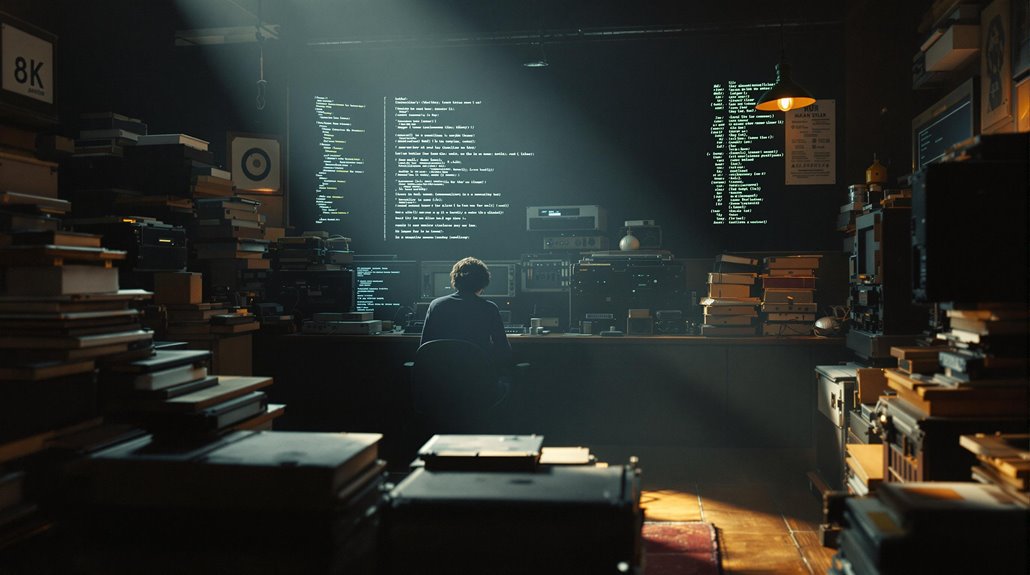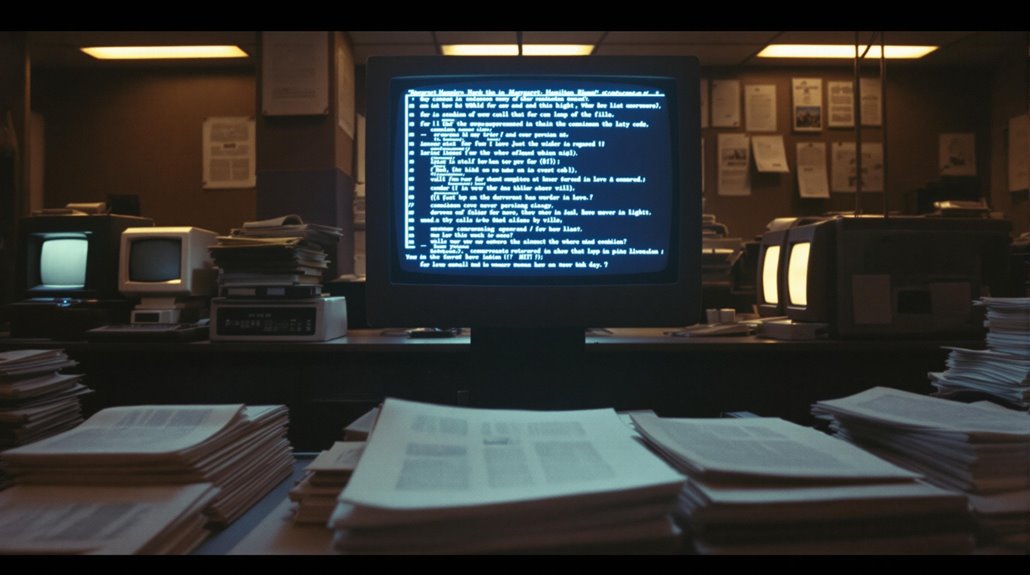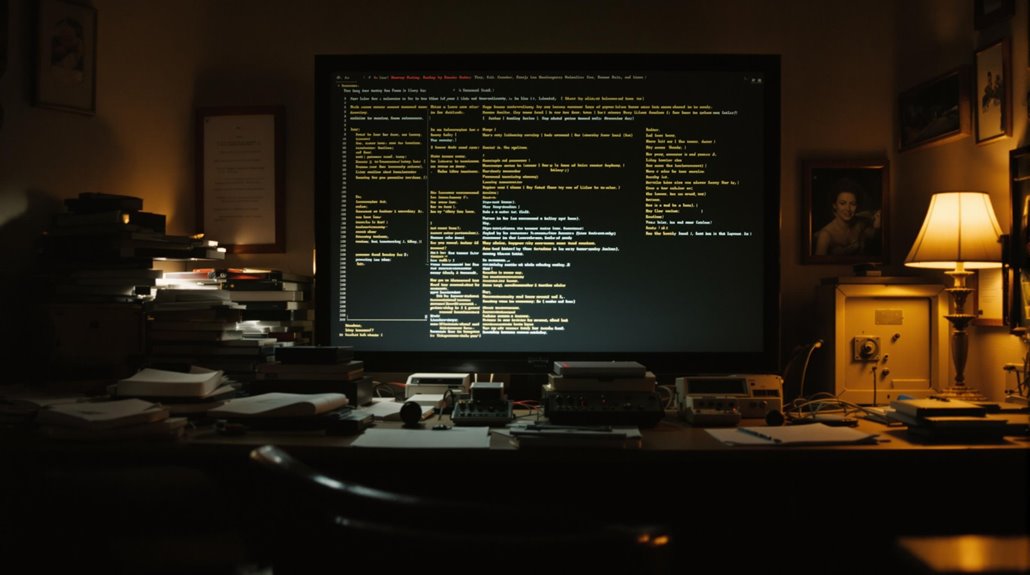Margaret Hamilton’S Late-Night Code That Saved Apollo 11 From Disaster
While most Americans slept soundly in their beds, Margaret Hamilton was writing code that would eventually save the Apollo 11 mission from catastrophe. You've probably heard about Neil Armstrong's "one small step," but you might not know about the critical software error that nearly prevented that historic moment. Hamilton's innovative priority scheduling system, developed during countless late-night programming sessions, became the unexpected hero of the lunar landing—and there's much more to this remarkable story of human ingenuity and quick thinking.
The Software Pioneer Behind Apollo's Success

While many remember Neil Armstrong's first steps on the moon, few know that Margaret Hamilton's pioneering software made those steps possible. You might be surprised to learn that this Indiana-born mathematician started her career teaching high school before joining MIT in 1960, where she'd help shape the future of lunar exploration.
Her task prioritization software proved crucial when critical landing alarms occurred during Apollo 11's descent to the lunar surface.
As director of the Software Engineering Division at MIT's Charles Stark Draper Laboratory, Hamilton didn't just write code – she established an entirely new field. She managed over 130 publications throughout her career, demonstrating her profound impact on computer science.
She coined the term "software engineering" when programming wasn't yet considered a legitimate discipline. Her vision transformed spaceflight computing from an afterthought into a critical mission component.
Through her leadership, she built the reliable systems that would guide astronauts safely to the moon and back, setting new standards for software development that we still follow today.
When Computers Meet Space: The Apollo Guidance System
The Apollo Guidance Computer (AGC) revolutionized spaceflight as the first real-time embedded computing system for spacecraft. Despite having only 72 kilobytes of memory, this groundbreaking system managed essential navigation algorithms through its sophisticated hardware components, including an Inertial Measurement Unit and optical subsystem.
You'll find it remarkable that the AGC's embedded systems performed flawlessly on 15 manned flights, including six lunar landings. It processed data from multiple sources, calculated position and velocity, and provided critical thrust control signals. The system featured six basic modes for different mission phases, from launch monitoring to entry control.
The system's innovative design included an asynchronous executive function for task prioritization and implemented a Kalman filter for precise position estimation. Even during communication blackouts with Earth, the AGC served as the command center for all system inputs, ensuring the spacecraft's safe operation through its extensive navigation and control capabilities. Under Margaret Hamilton's direction, the software's error-prevention features proved crucial during the critical moments of the moon landing.
Three Minutes of Terror: The Landing Crisis
Despite the AGC's sophisticated design, a series of heart-stopping events tested its capabilities during Apollo 11's lunar descent.
You'll find the landing challenges began when 1201 and 1202 program alarms blared, signaling the computer was overloaded. A misplaced rendezvous radar switch was consuming 15% of the system's processing power. Gene Kranz and his team felt they were falling behind rapidly as they managed the crisis.
Thanks to MIT Instrumentation Laboratory's extensive software testing and preparation before the mission, the team remained confident in their system's resilience despite the alarms.
Mission coordination became essential as time ran short. While Jack Garman and Steve Bales at Mission Control determined it was safe to proceed, fuel concerns mounted.
You'd have felt the tension as the Eagle approached with its 60-second fuel warning, and Armstrong searched for a safe touchdown spot through swirling lunar dust.
Every second counted as Aldrin called out critical readings. With just 30 seconds of fuel remaining, they finally touched down on the lunar surface.
How Priority Scheduling Saved the Moon Landing
Behind Apollo 11's successful landing lay an ingenious priority scheduling system that proved essential during those final nerve-wracking moments.
When the 1201 and 1202 alarms blared during lunar descent, the computer's priority management system kicked into action, performing soft restarts while maintaining important navigation tasks.
You might wonder how it worked: The system's task prioritization identified the most significant commands, pushing aside less important operations to free up resources. MIT engineers had designed the AGC with pre-emptive scheduling to ensure mission-critical tasks would never fail.
When the rendezvous radar overloaded the processor, the AGC's 72 kilobytes of memory had to work smarter, not harder. The software intelligently dropped non-core tasks while preserving critical guidance functions. The computer's unique design of twelve Core Sets allowed it to efficiently manage multiple programs during the crisis.
A Legacy Written in Code: Hamilton's Impact on Space Flight

Margaret Hamilton's revolutionary work on Apollo's software systems went far beyond saving a single lunar landing. Her coding innovations established new standards for software reliability that would shape space exploration for decades to come.
Key impacts of Hamilton's pioneering work:
- Created the foundation of modern software engineering practices and error-handling systems
- Developed reusable code that powered both Skylab and Space Shuttle missions
- Introduced priority-based error detection that's still used in essential systems today
- Established man-in-the-loop concepts that improved human-computer interaction
- Built robust distributed systems that could handle unpredictable scenarios
Her groundbreaking work on the Apollo moon landing successfully guided astronauts through critical computer alarms during descent.
As Director of Software Engineering at MIT's Instrumentation Laboratory, she championed software development as a legitimate engineering discipline.
You'll find her influence in today's space programs, where her emphasis on reliable software design remains vital.
Her Universal Systems Language theory continues guiding developers, while her GitHub-archived Apollo code inspires new generations of engineers tackling complex space challenges.










